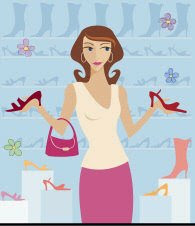By: Erika Kelley

Women and cats. What do we have in common? It has to be something because women are frequently dubbed “catty.” I would like to think it’s because we’re:
· Protective -- like a mother cat is protective of her kittens;
· Teachers -- able to teach our children the way cats teach their kits -- to survive in the world, fix their own meals, share it (there's usually always room for one more in the heap), and to clean up afterwards;
· Able to live balanced lives -- like cats -- every day needs some down time for a stretch and a purr session and we understand that play time is valuable;
· Gardeners -- like cats, we realize that gardening is a great stress-reducer;
· Respectful -- like cats, we have respect for our elders; and
· Successful -- like cats, we’re able to climb to new heights!
No doubt about it, this is all true; however, we’ve been dubbed, “catty” for reasons more closely aligned with Marcia Ellet, J. Andy Murphy, and Terri Laforest’s book, “
The Catty, Catty Ways of Women in the Workplace,” where they explore the way women treat one another in the workplace focusing on gossiping, backstabbing, manipulation, and other situations that cause the claws to come out and the fur to fly.
I would argue, however, that this common stereotype, that women are “catty,” is unfair, untrue, and an unfortunate generalization. Of course, we’ve all had our fair share of “catty” interactions. But in comparison to the number of kind and caring acts that we experience from women (family, friends, colleagues, and even strangers), I think it’s safe to say that "catty" behavior is few, far, and in between.
My thought: the negative interactions typically overshadow the positive. It’s like driving. No one really thinks about the number of polite drivers that adhere to the speed limit, allow us to merge with ease, etc. It’s the few drivers with road rage and the ones that don’t wave to us (to say thank you) when we allow them to get in front us that we remember.
Case and point…
I broke down on a major highway earlier this week. While sitting in the car, with the windows up, waiting for my husband to rescue me, I heard a woman yell:
Oh (insert explicative) no! Better get to pushing! I found myself thinking: you “catty” chick! I’m sure if she found herself broken down on the highway, she wouldn’t appreciate someone barfing out trash to her under the most vulnerable of circumstances. I sent my husband and a few of my girlfriends a text message describing this incident.
Rewind…
I broke down on a major highway earlier this week. While sitting in the car, with the windows up, waiting for my husband to rescue me, a woman pulled up alongside of me and pointed to her cell phone and mouthed the words:
are you okay? Do you have a cell phone? I couldn’t roll down my windows because the battery completely died; so, I held up my cell phone to her and smiled. She returned the smile, nodded, and continued on her way. Shortly thereafter, another woman passed by. I heard her yell:
Oh (insert explicative) no! Better get to pushing! As you noticed, there was no mention of the first incident in my text message to my husband or girlfriends. The kindness that I experienced from this female stranger was not out of the norm. In fact, the majority of female strangers with which I have interacted have been kind and respectful as opposed to rude and obnoxious like the woman on the highway. Yet, the negative woman on the highway completely overshadowed the kind gesture displayed by the other woman on the highway!
Shame on me for reinforcing this negative behavior and terms, like “catty,” that are used to impart negative attitudes towards women. What’s worse is that I’m not alone. Negative female stereotypes have been exploited and perpetrated in films (
Mean Girls) and on TV (
Gossip Girl). The mass media projects images of girls’ meanness and fighting that reinforces long-standing stereotypes of catty, untrustworthy, manipulative, and gossipy behavior.
But there is hope…we can all do our part to counter these stereotypes. I am convinced that positive action will counter negative images!
Supportive, caring, and loving women who I have grown to love and adore, surround me. So, I plan to constantly remind myself of these positive women as opposed to allowing the negative female interactions to consume me. I also plan to share more of these positive female relationships, instead of the negative, in hopes of slowly, but assuredly, changing negative female stereotypes into positive ones.
So, what will you do (or continue to do) to contribute towards countering negative female stereotyping?








